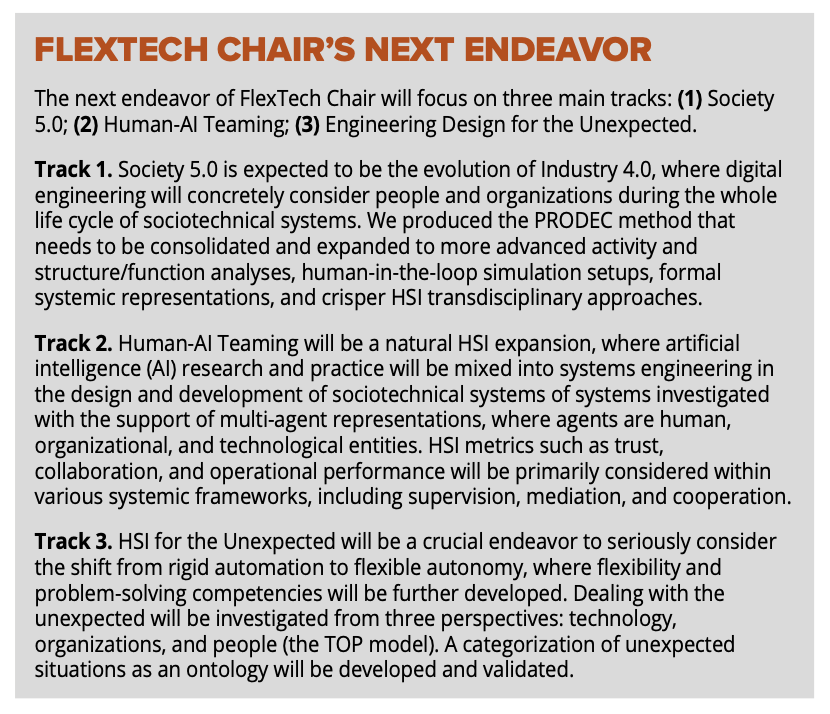FlexTech Chair’s founder, Professor Guy André Boy, briefly traces the development of human systems integration
Since 2019, the FlexTech Chair has successfully contributed to the discipline of human systems integration in the increasingly autonomous systems niche. This ongoing program focuses on five key objectives:
- Train FlexTech staff and partners in HSI management and leadership;
- Conduct appropriate research efforts with industrial partners;
- Create and teach courses at program member graduate schools and beyond;
- Publish in top-level journals and conferences;
- Continue to lead HSI globally within the industry, academic community, and the best professional associations.
Human systems integration (HSI) seriously considers people and organizations in designing new technology by continuously developing approaches, methods, and tools that support engineering designers and systems architects, and ultimately human-systems integrators. HSI is at the intersection of human and social sciences, systems engineering, human- computer interaction (HCI), and Artificial Intelligence (AI). It supports digital engineering in the development of life-critical complex systems. In addition to its involvement in cutting-edge research and teaching, the FlexTech Chair has consulting resources to support the industry in its strategic
and tactical efforts.
Developing a human systems integration ontology
We contributed to developing a consistent terminology and, to some extent, an acceptable ontology in the rapidly expanding field of human systems integration (HSI). We often define HSI as a process and a product at the confluence of several areas, such as systems engineering, human factors and ergonomics, information technology, and specific sectors, such as aerospace, health, and energy. It is a broader transdisciplinary field in our increasingly complex human-machine world that focuses on integrating technology, organizations, and people within a complex sociotechnical system throughout its life cycle.
Therefore, HSI is no longer a question of usability and user interface design once a complex machine is technologically developed but also about considering people and organizations early in the design and development processes. Indeed, rooted in industrial engineering research and operational worlds, HSI requires a deeper foundation based on an epistemological approach. This assertion is even more crucial today as technology has become predominantly digital, and, more specifically, the concept of the digital twin is emphasized because it has become essential to support model-based HSI (MB-HSI). In other words, software-based assistant systems are replacing traditional tools.
Therefore, appropriate social-cognitive (multi-agent) models and methods are helpful throughout the life cycle of contemporary sociotechnical designs to account for the complexity and tangibility of their human-centered context-sensitive architectures, combining procedural and declarative knowledge. Considering these reasons, this article provides a set of fundamental axioms, some theoretical abstractions, and valuable practical models, which are presented and illustrated through an evolutionary HSI ontology.
Until the 1980s, most tasks and activities were primarily physical.

Thus, human factors have long been linked to biomechanics, physiological health, and safety. For this reason, HFE specialists were primarily physiologists and bio-mechanists. Then, computing capabilities developed considerably over the last two decades of the 20th century. For example, several onboard computer systems were created and installed on aircraft. More importantly, from this point onward, HCI emerged as a discipline not only because microcomputers invaded all areas of our lives, including our homes, but also because there was a need to master emerging cognitive activities.
In this way, cognitive psychology and anthropology had a huge role in the development of cognitive engineering, which greatly supported HCI. Then, HCI gradually penetrated HFE. HCI researchers and practitioners developed numerous task analysis methods during the 1980s and 1990s, and most importantly, interaction design became an effective practice. Human-Centered Design (HCD) began to develop within HCI and thus was limited to computer systems: some have called it Human-Centered Computing!
Then, in the first two decades of the 21st century, the power of software and computer networks began to offer a wide range of possibilities, including improved modeling and simulation, more meaningful visualizations, advanced interaction media, and AI. These new capabilities have led to a radical departure from traditional engineering practices. Indeed, digital engineering has become a concrete industrial practice that enables virtual testing of activities at the design stage and, of course, throughout the life cycle of a system.
At the same time, complexity has increased dramatically due to global interconnectivity. HSI has, therefore, naturally become one of the major disciplines to support the management and mastery of this digital shift. As the user interface gradually emerged as a syndrome of 20th-century technology- centered processes, STS designers began to realize that it was possible to include people throughout the life cycle of a system.
For a long time, automation and human error have led technology-centered approaches to view people as problems rather than solutions to emerging critical issues. This view is mainly due to the failure to consider the evolution of operational contexts and the maturity of STSs. Indeed, eliminating humans from the control and decision-making loops can solve problems when the context is very well specified and covers many expected situations.
However, in unexpected situations, humans must solve problems ‘on their own’ but often need the help of more knowledgeable and experienced technological, organizational, and human resources. Our research program approach follows James Reason’s statement: “Fallibility is part of the human condition. Although we cannot change the human condition, we can change the conditions under which humans work.”
You should consider coming to FlexTech Chair Spring School on Human-AI Teaming
Further Reading
Please have a look at this article (9.4 impact factor)
References
- Boy, G.A., Masson, D., Durnerin, E. & Morel C. (2024). PRODEC for Human Systems Integration of Increasingly Autonomous Systems. Systems Engineering Journal. Wiley, USA
- Boy, G.A. (2023). AN EPISTEMOLOGICAL APPROACH TO HUMAN SYSTEMS INTEGRATIOn. Technology in Society Journal, 102298. https://doi.org/10.1016/j.techsoc.2023.102298
- Boy, G.A. (2023). Uncertainty management in human systems integration of life-critical systems. In Griffin, Mark A., and Gudela Grote (eds). THE OXFORD HANDBOOK OF UNCERTAINTY MANAGEMENT IN WORK ORGANIZATIONS (online edn, Oxford Academic, 20 Oct. 2022), Oxford University Press, UK, accessed 6 Dec. 2022.
- Boy, G.A. (2022). MODEL-BASED HUMAN SYSTEMS INTEGRATION. In the Handbook of Model-Based Systems Engineering, A.M. Madni & N. Augustine (Eds.). Springer, USA. DOI: HTTPS://DOI.ORG/10.1007/978-3-030-27486-3_28-1.
- Boy, G.A. (2021). DESIGN FOR FLEXIBILITY – A HUMAN SYSTEMS INTEGRATION APPROACH. Springer Nature, Switzerland. ISBN: 978-3-030-76391-6.
- Boy, G.A. (2021). SOCIOERGONOMICS: A FEW CLARIFICATIONS ON THE TECHNOLOGY- ORGANIZATIONS-PEOPLE TRYPTIC. Proceedings of INCOSE HSI2021 International Conference, WILEY ONLINE LIB.
- Boy, G.A. (2020). Human Systems Integration: From Virtual to Tangible. CRC Press – Taylor & Francis Group, USA (HTTPS://WWW.TAYLORFRANCIS.COM/BOOKS/9780429351686).
- Boy, G.A. & Kennedy, G. Eds. (2023). Human Systems Integration Primer Volume One. INCOSE, San Diego, CA, USA. ISBN 978-1-937076-12-2.
- Boy, G.A. & Quillerou, E. (2022). Risk-Taking, Prevention and Design: A Cross-Fertilization Approach. CRC Press, Taylor & Francis, USA.
- Boy, G.A. (2021). Design for Flexibility – A Human Systems Integration Approach. Springer Nature, Switzerland. ISBN: 978-3-030-76391-6.

This work is licensed under Creative Commons Attribution-NonCommercial-NoDerivatives 4.0 International.


